Uncertainties in Pollution and Risk Assessments of Heavy Metals in Lake Sediments Using Regional Background Soils in China
Abstract
:1. Introduction
2. Materials and Methods
2.1. Study Area
2.2. Sampling and Analysis
2.3. Pollution and Ecological Risk Assessments
2.3.1. Enrichment Factor (EF)
2.3.2. Nemerow Pollution Index (NPI)
2.3.3. Potential Ecological Risk
3. Results and Discussion
3.1. Heavy Metals in the Five Lakes’ Present and Background Sediments and in Regional Background Soils
3.2. A Comparison of Assessing Metal Pollution and Risks between Using Regional Background Soils and Background Sediments in These Lakes
3.3. Causes for the Uncertainties in Assessing Heavy Metal Pollution and Ecological Risks Using Regional Background Soils
3.4. Pollution and Risks of the Nine Metals in the Lakes
4. Environmental Significance and Conclusions
Author Contributions
Funding
Institutional Review Board Statement
Informed Consent Statement
Data Availability Statement
Acknowledgments
Conflicts of Interest
References
- Qin, Y.; Tao, Y. Pollution status of heavy metals and metalloids in Chinese lakes: Distribution, bioaccumulation and risk assessment. Ecotoxicol. Environ. Saf. 2022, 248, 114293. [Google Scholar] [CrossRef] [PubMed]
- Yang, G.; Ma, R.; Zhang, L.; Jiang, J.; Yao, S.; Zhang, M.; Zeng, H. Lake status major problems and protection strategy in China. J. Lake Sci. 2010, 22, 799–810. [Google Scholar]
- Rahman, A.; Haque, M.A.; Ghosh, S.; Shinu, P.; Attimarad, M.; Kobayashi, G. Modified Shrimp-Based Chitosan as an Emerging Adsorbent Removing Heavy Metals (Chromium, Nickel, Arsenic, and Cobalt) from Polluted Water. Sustainability 2023, 15, 2431. [Google Scholar] [CrossRef]
- Guo, W.; Huo, S.; Xi, B.; Zhang, J.; Wu, F. Heavy metal contamination in sediments from typical lakes in the five geographic regions of China: Distribution, bioavailability, and risk. Ecol. Eng. 2015, 81, 243–255. [Google Scholar] [CrossRef]
- Li, D.; Yu, R.; Chen, J.; Leng, X.; Zhao, D.; Jia, H.; An, S. Ecological risk of heavy metals in lake sediments of China: A national-scale integrated analysis. J. Clean. Prod. 2022, 334, 130206. [Google Scholar] [CrossRef]
- Wang, M.; Bao, K.; Heathcote, A.J.; Zhu, Q.; Cheng, G.; Li, S.; Zhang, C. Spatio-temporal pattern of metal contamination in Chinese lakes since 1850. Catena 2021, 196, 104918. [Google Scholar] [CrossRef]
- Zhang, L.; Shao, H. Heavy metal pollution in sediments from aquatic ecosystems in China. Clean–Soil Air Water 2013, 41, 878–882. [Google Scholar] [CrossRef]
- Chiaia-Hernández, A.C.; Casado-Martinez, C.; Lara-Martin, P.; Bucheli, T.D. Sediments: Sink, archive, and source of contaminants. Environ. Sci. Pollut. Res. 2022, 29, 85761–85765. [Google Scholar] [CrossRef]
- Chuan, O.M.; Yunus, K. Sediment and organisms as marker for metal pollution. In Monitoring of Marine Pollution; IntechOpen: London, UK, 2019; pp. 1–19. [Google Scholar]
- Dung, T.T.T.; Cappuyns, V.; Swennen, R.; Phung, N.K. From geochemical background determination to pollution assessment of heavy metals in sediments and soils. Rev. Environ. Sci. Bio/Technol. 2013, 12, 335–353. [Google Scholar] [CrossRef]
- Li, Y.; Cheng, X.; Liu, K.; Yu, Y.; Zhou, Y. A new method for identifying potential hazardous areas of heavy metal pollution in sediments. Water Res. 2022, 224, 119065. [Google Scholar] [CrossRef]
- Yan, Y.; Han, L.; Yu, R.; Hu, G.; Zhang, W.; Cui, J.; Yan, Y.; Huang, H. Background determination, pollution assessment and source analysis of heavy metals in estuarine sediments from Quanzhou Bay, southeast China. Catena 2020, 187, 104322. [Google Scholar] [CrossRef]
- Cheng, H.; Li, M.; Zhao, C.; Yang, K.; Li, K.; Peng, M.; Yang, Z.; Liu, F.; Liu, Y.; Bai, R.; et al. Concentrations of toxic metals and ecological risk assessment for sediments of major freshwater lakes in China. J. Geochem. Explor. 2015, 157, 15–26. [Google Scholar] [CrossRef]
- Gu, X.; Han, X.; Han, Y.; Luo, W.; Feng, M.; Xu, D.; Xing, P.; Wu, Q.L. Sedimentary records and stable lead isotopes reveal increasing anthropogenic impacts on heavy metal accumulation in a plateau lake of China over the last 100 years. J. Hazard. Mater. 2022, 440, 129860. [Google Scholar] [CrossRef]
- Han, L.; Gao, B.; Hao, H.; Zhou, H.; Lu, J.; Sun, K. Lead contamination in sediments in the past 20 years: A challenge for China. Sci. Total Environ. 2018, 640–641, 746–756. [Google Scholar] [CrossRef]
- Luo, M.; Kang, X.; Liu, Q.; Yu, H.; Tao, Y.; Wang, H.; Niu, Y.; Niu, Y. Research on the geochemical background values and evolution rules of lake sediments for heavy metals and nutrients in the Eastern China Plain from 1937 to 2017. J. Hazard. Mater. 2022, 436, 129136. [Google Scholar] [CrossRef]
- Qu, C.; Li, B.; Wu, H.; Wang, S.; Li, F. Probabilistic ecological risk assessment of heavy metals in sediments from China’s major aquatic bodies. Stoch. Environ. Res. Risk Assess. 2016, 30, 271–282. [Google Scholar] [CrossRef]
- Shou, Y.; Zhao, J.; Zhu, Y.; Qiao, J.; Shen, Z.; Zhang, W.; Han, N.; Núñez-Delgado, A. Heavy metals pollution characteristics and risk assessment in sediments and waters: The case of Tianjin, China. Environ. Res. 2022, 212, 113162. [Google Scholar] [CrossRef]
- Xu, Y.; Wu, Y.; Han, J.; Li, P. The current status of heavy metal in lake sediments from China: Pollution and ecological risk assessment. Ecol. Evol. 2017, 7, 5454–5466. [Google Scholar] [CrossRef]
- Zhang, W.; Jin, X.; Di, Z.; Zhu, X.; Shan, B. Heavy metals in surface sediments of the shallow lakes in eastern China: Their relations with environmental factors and anthropogenic activities. Environ. Sci. Pollut. Res. 2016, 23, 25364–25373. [Google Scholar] [CrossRef]
- Xu, M.; Sun, W.; Wang, R. Spatial Distribution and Ecological Risk Assessment of Potentially Harmful Trace Elements in Surface Sediments from Lake Dali, North China. Water 2019, 11, 2544. [Google Scholar] [CrossRef] [Green Version]
- China National Environmental Monitoring Center. The Background Values of Elements in Chinese Soils; Environmental Science Press China: Beijing, China, 1990; pp. 330–496. [Google Scholar]
- Wan, D.; Yang, H.; Jin, Z.; Xue, B.; Song, L.; Mao, X.; Yang, J. Spatiotemporal trends of atmospheric Pb over the last century across inland China. Sci. Total Environ. 2020, 729, 138399. [Google Scholar] [CrossRef] [PubMed]
- Zhan, C.; Wan, D.; Han, Y.; Zhang, J. Historical variation of black carbon and PAHs over the last ~200 years in central North China: Evidence from lake sediment records. Sci. Total Environ. 2019, 690, 891–899. [Google Scholar] [CrossRef] [PubMed]
- Wan, D.; Han, Y.; Song, L.; Ning, D.; Jiang, Q. Sediment records of black carbon variations over the last two centuries in North China. Sci. Total Environ. 2023, 888, 164189. [Google Scholar] [CrossRef] [PubMed]
- Wan, D.; Yang, H.; Song, L.; Jin, Z.; Mao, X.; Yang, J. Sediment records of global and regional Hg emissions to the atmosphere in North China over the last three centuries. Environ. Pollut. 2022, 310, 119831. [Google Scholar] [CrossRef] [PubMed]
- Wan, D.; Song, L.; Mao, X.; Yang, J.; Jin, Z.; Yang, H. One-century sediment records of heavy metal pollution on the southeast Mongolian Plateau: Implications for air pollution trend in China. Chemosphere 2019, 220, 539–545. [Google Scholar] [CrossRef]
- Yang, H.; Turner, S.; Rose, N.L. Mercury pollution in the lake sediments and catchment soils of anthropogenically-disturbed sites across England. Environ. Pollut. 2016, 219, 1092–1101. [Google Scholar] [CrossRef] [Green Version]
- Wan, D.; Song, L.; Yang, J.; Jin, Z.; Zhan, C.; Mao, X.; Liu, D.; Shao, Y. Increasing heavy metals in the background atmosphere of central North China since the 1980s: Evidence from a 200-year lake sediment record. Atmos. Environ. 2016, 138, 183–190. [Google Scholar] [CrossRef]
- Wan, D.; Mao, X.; Jin, Z.; Song, L.; Yang, J.; Yang, H. Sedimentary biogeochemical record in Lake Gonghai: Implications for recent lake changes in relatively remote areas of China. Sci. Total Environ. 2019, 649, 929–937. [Google Scholar] [CrossRef]
- Yang, H.; Battarbee, R.W.; Turner, S.D.; Rose, N.L.; Derwent, R.G.; Wu, G.; Yang, R. Historical reconstruction of mercury pollution across the Tibetan Plateau using lake sediments. Environ. Sci. Technol. 2010, 44, 2918–2924. [Google Scholar] [CrossRef]
- Abdelaal, A.; Abdelkader, A.I.; Alshehri, F.; Elatiar, A.; Almadani, S.A. Assessment and Spatiotemporal Variability of Heavy Metals Pollution in Water and Sediments of a Coastal Landscape at the Nile Delta. Water 2022, 14, 3981. [Google Scholar] [CrossRef]
- Wan, D.; Zhan, C.; Yang, G.; Liu, X.; Yang, J. Preliminary Assessment of Health Risks of Potentially Toxic Elements in Settled Dust over Beijing Urban Area. Int. J. Environ. Res. Public Health 2016, 13, 491. [Google Scholar] [CrossRef] [Green Version]
- Wan, D.; Han, Z.; Yang, J.; Yang, G.; Liu, X. Heavy Metal Pollution in Settled Dust Associated with Different Urban Functional Areas in a Heavily Air-Polluted City in North China. Int. J. Environ. Res. Public Health 2016, 13, 1119. [Google Scholar] [CrossRef] [Green Version]
- Shen, F.; Mao, L.; Sun, R.; Du, J.; Tan, Z.; Ding, M. Contamination Evaluation and Source Identification of Heavy Metals in the Sediments from the Lishui River Watershed, Southern China. Int. J. Environ. Res. Public Health 2019, 16, 336. [Google Scholar] [CrossRef] [Green Version]
- Su, K.; Wang, Q.; Li, L.; Cao, R.; Xi, Y. Water quality assessment of Lugu Lake based on Nemerow pollution index method. Sci. Rep. 2022, 12, 13613. [Google Scholar] [CrossRef]
- Yu, L.; Zhang, F.; Zang, K.; He, L.; Wan, F.; Liu, H.; Zhang, X.; Shi, Z. Potential Ecological Risk Assessment of Heavy Metals in Cultivated Land Based on Soil Geochemical Zoning: Yishui County, North China Case Study. Water 2021, 13, 3322. [Google Scholar] [CrossRef]
- Hakanson, L. An ecological risk index for aquatic pollution control. A sedimentological approach. Water Res. 1980, 14, 975–1001. [Google Scholar] [CrossRef]
- Lu, X.; Wu, X.; Wang, Y.; Chen, H.; Gao, P.; Fu, Y. Risk assessment of toxic metals in street dust from a medium-sized industrial city of China. Ecotoxicol. Environ. Saf. 2014, 106, 154–163. [Google Scholar] [CrossRef]
- Wan, D.; Yang, G.; Yang, J.; Zhan, C. Ecological Risks and Spatial Distributions of Heavy Metals in Beijing Atmospheric Dust. Pol. J. Environ. Stud. 2018, 27, 881–887. [Google Scholar] [CrossRef]
- Su, X.; Ling, H.; Wu, D.; Xue, Q.; Xie, L. Spatial–Temporal Variations, Ecological Risk Assessment, and Source Identification of Heavy Metals in the Sediments of a Shallow Eutrophic Lake, China. Toxics 2022, 10, 16. [Google Scholar] [CrossRef]
- Liang, M.; Liu, E.; Wang, X.; Zhang, Q.; Xu, J.; Ji, M.; Zhang, E. Historical trends in atmospheric metal(loid) contamination in North China over the past half-millennium reconstructed from subalpine lake sediment. Environ. Pollut. 2022, 304, 119195. [Google Scholar] [CrossRef]
- Gu, Y.; Zhang, T.; Bai, H. Classification of soil environmental background value attributes in Inner Mongolia. Inner Mongolia Environ. Prot. 1995, 7, 6–9. [Google Scholar]
- Gao, L.; Long, H.; Chen, X.; Zhang, D.; Lin, C. Comparation of organic carbon and nitrogen contents and densities of major soil orders in Hebei province based on Chinese soil taxonomy. Jiangsu J. Agr. Sci. 2022, 38, 657–665. [Google Scholar]
- Rahman, A.; Yoshida, K.; Islam, M.M.; Kobayashi, G. Investigation of Efficient Adsorption of Toxic Heavy Metals (Chromium, Lead, Cadmium) from Aquatic Environment Using Orange Peel Cellulose as Adsorbent. Sustainability 2023, 15, 4470. [Google Scholar] [CrossRef]
- Agyeman, P.C.; Kebonye, N.M.; John, K.; Haghnazar, H.; Boruvka, L.; Vasat, R. Compositional mapping, uncertainty assessment, and source apportionment via pollution assessment-based receptor models in urban and peri-urban agricultural soils. J. Soils Sediments 2023, 23, 22. [Google Scholar] [CrossRef]
- Haghnazar, H.; Belmont, P.; Johannesson, K.H.; Aghayani, E.; Mehraein, M. Human-induced pollution and toxicity of river sediment by potentially toxic elements (PTEs) and accumulation in a paddy soil-rice system: A comprehensive watershed-scale assessment. Chemosphere 2023, 311, 14. [Google Scholar] [CrossRef]
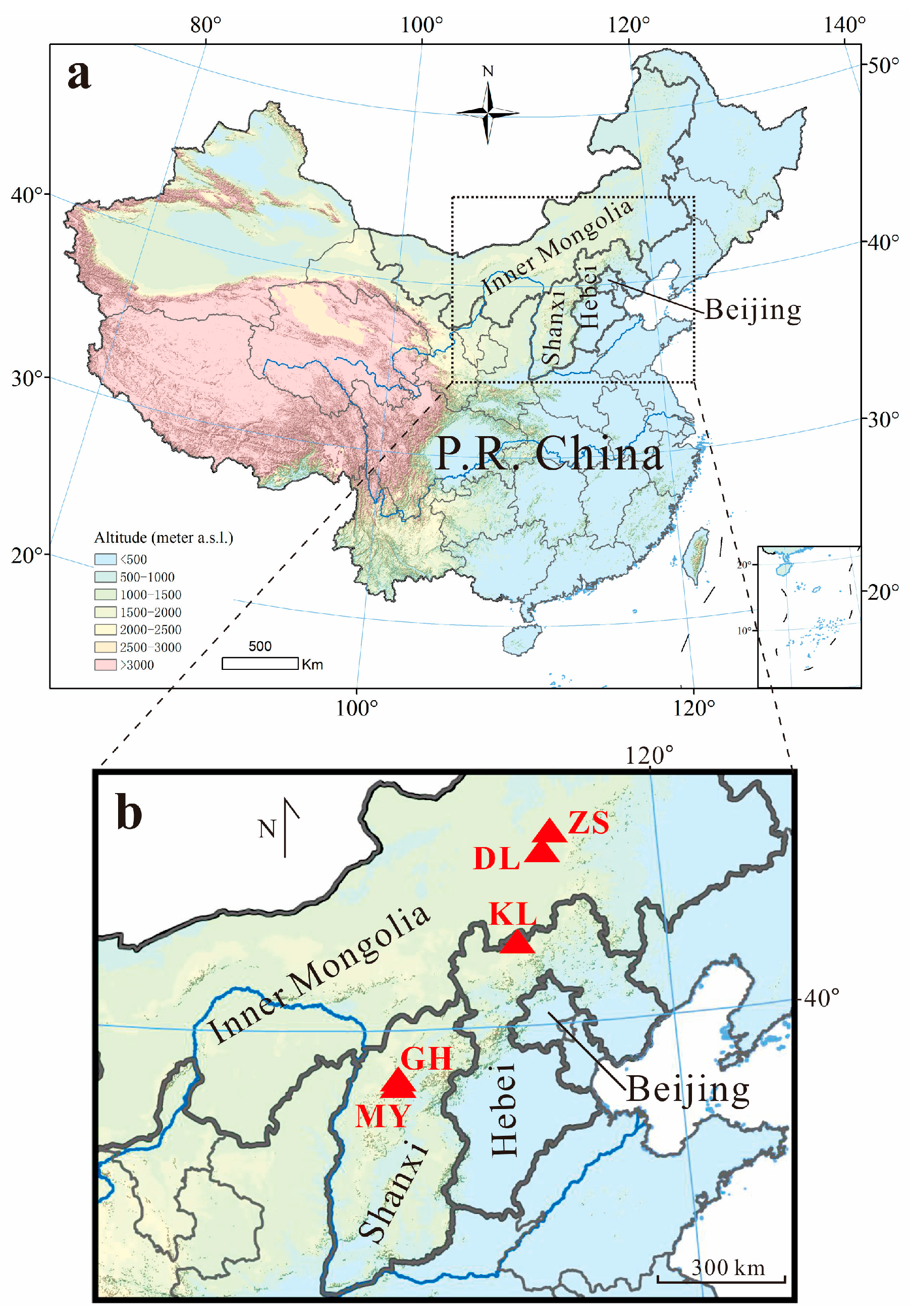
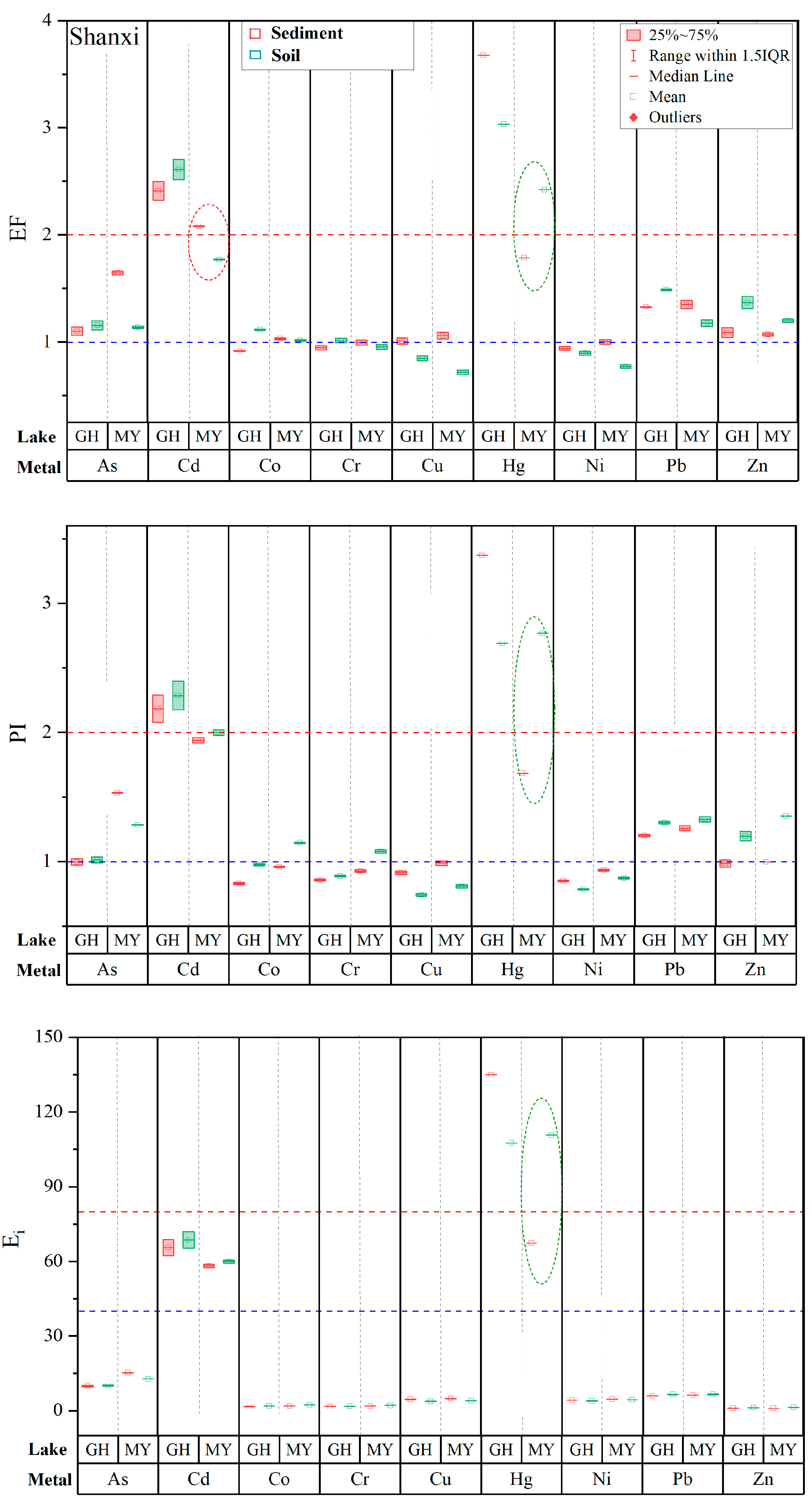

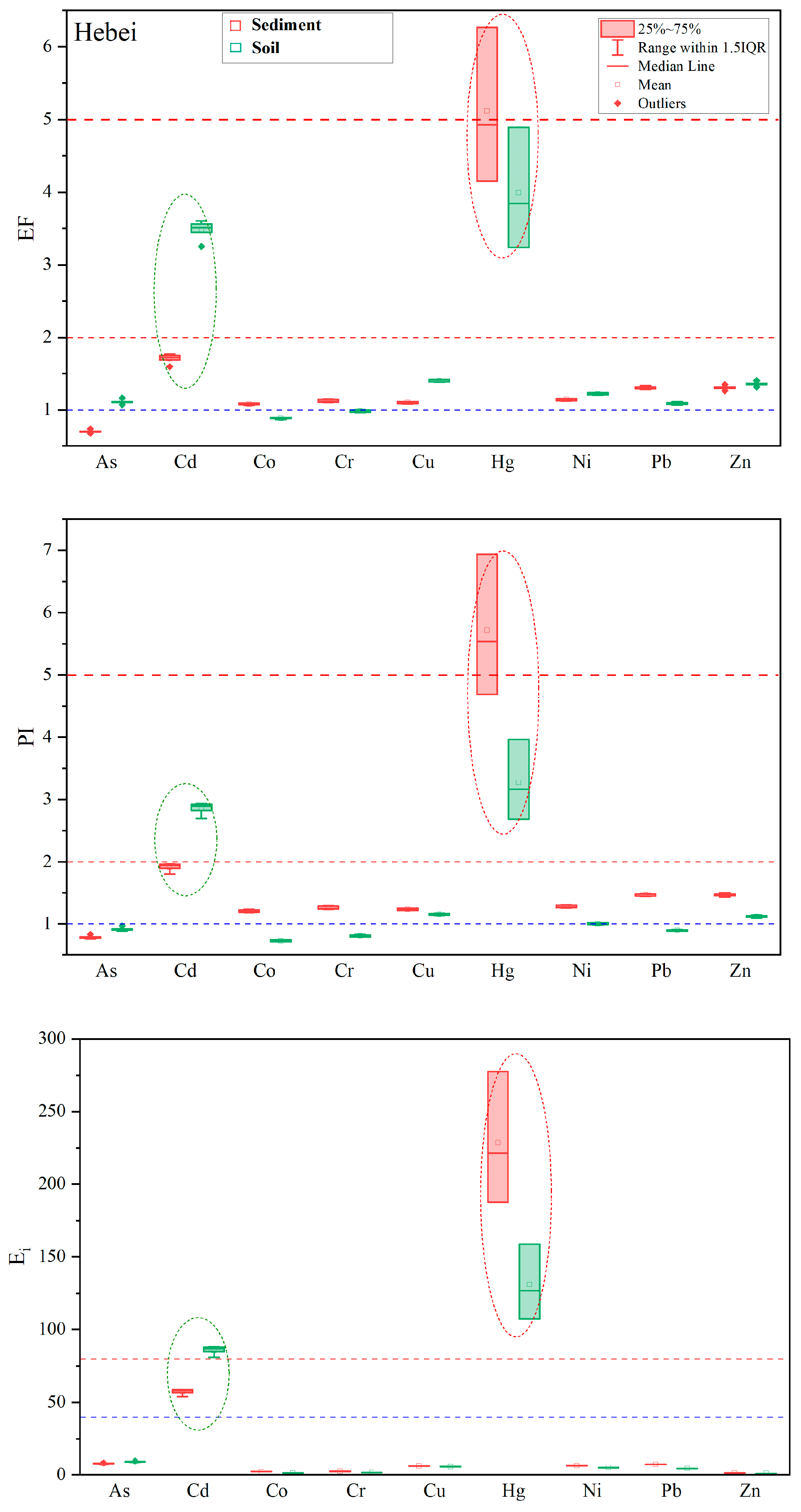

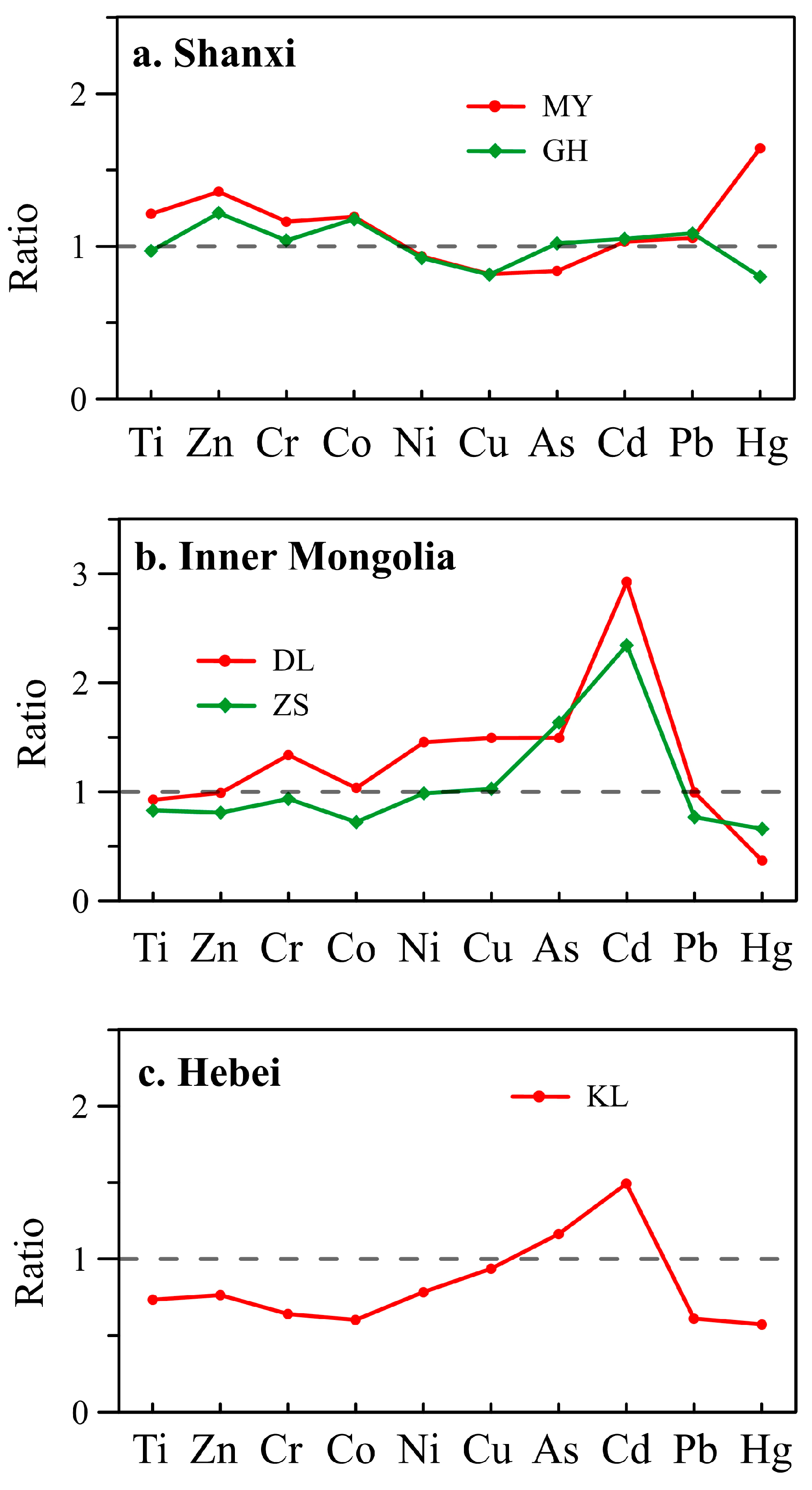
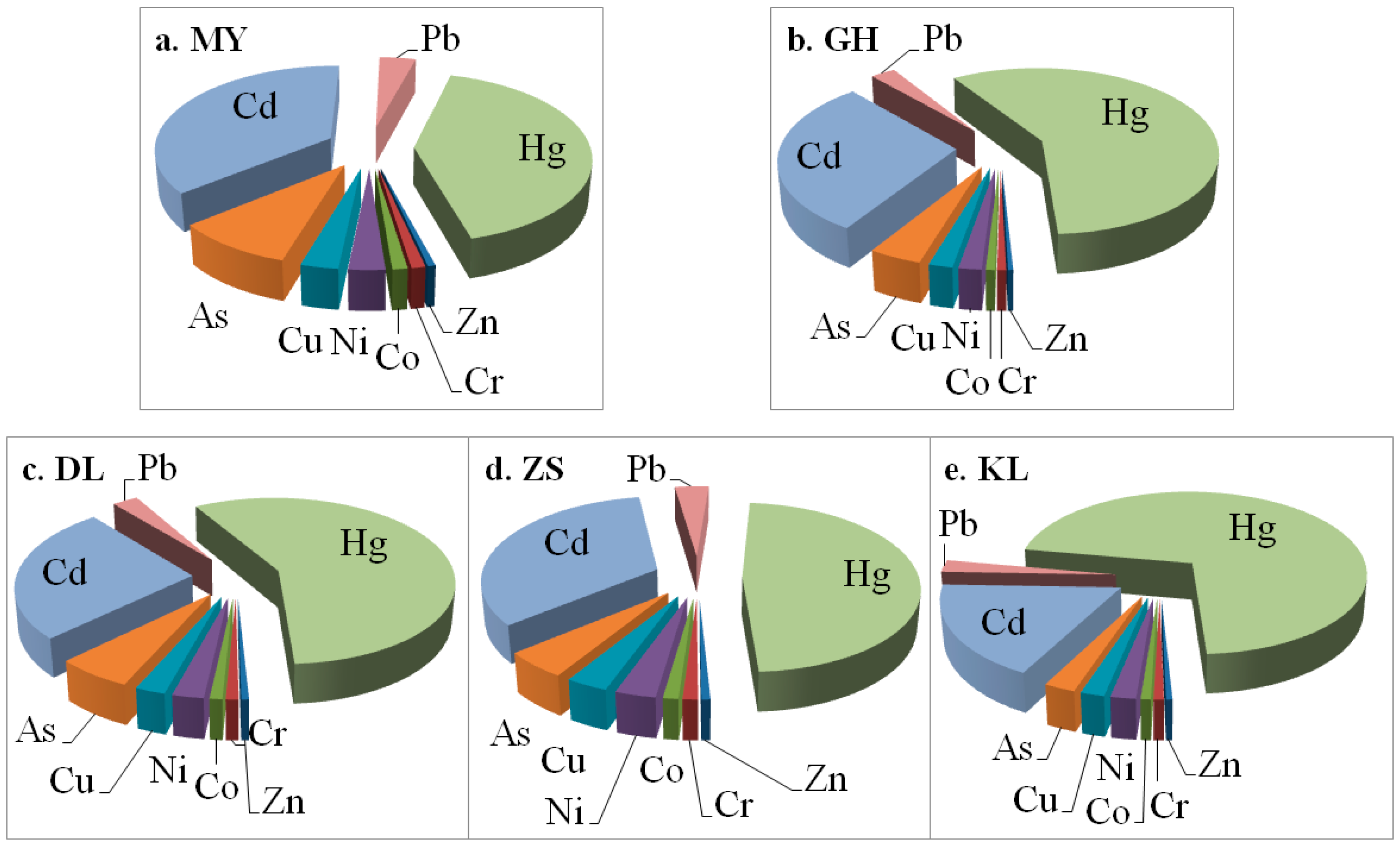
| Province | Lake | Lake Location | Elevation (m) | Lake Area (km2) | Maximum Water Depth (m) |
|---|---|---|---|---|---|
| Shanxi | GH | 38°54.3′–38°54.7′ N 112°14.3′–112°14.6′ E | 1860 | 0.21 | ~10 |
| MY | 38°51.9′–38°52.3′ N 112°12.3′–112°13.0′ E | 1776 | 0.45 | ~9 | |
| Inner Mongolia | DL | 43°13′–43°23′ N 116°29′–116°45′ E | 1222 | 238 | 11 |
| ZS | 43°41.0′–43°41.7′ N 116°53.1′–116°54.4′ E | 1299 | 1.6 | ~2 | |
| Hebei | KL | 41°42′0″–41°43′48″ N 115°41′42″–115°44′17″ E | 1375 | 4.0 | ~6 |
| Province | Lake | Item | Ti | Zn | Cr | Co | Ni | Cu | As | Cd | Pb | Hg |
|---|---|---|---|---|---|---|---|---|---|---|---|---|
| mg/kg | ng/g | |||||||||||
| Shanxi | MY | Average in 2010s | 4290 | 97.2 | 66.2 | 12.4 | 29.4 | 22.9 | 13.4 | 0.25 | 24.0 | 66.4 |
| SD | 75 | 0.1 | 1.2 | 0.1 | 0.3 | 0.5 | 0.04 | 0.004 | 0.5 | |||
| Background | 4607 | 97.6 | 71.5 | 12.9 | 31.5 | 23.2 | 8.7 | 0.13 | 19.1 | 39.4 | ||
| SD | 68 | 7.1 | 3.8 | 0.3 | 1.6 | 1.4 | 0.5 | 0.01 | 0.7 | 1.8 | ||
| Max | 4739 | 106.9 | 76.9 | 13.8 | 33.9 | 26.2 | 13.4 | 0.28 | 25.7 | 66.4 | ||
| Min | 4236 | 89.0 | 65.4 | 12.3 | 29.1 | 21.5 | 8.3 | 0.12 | 18.2 | 35.8 | ||
| GH | Average in 2010s | 3325 | 86.0 | 54.6 | 10.5 | 26.4 | 21.0 | 10.5 | 0.29 | 23.6 | 64.5 | |
| SD | 59 | 3.6 | 0.6 | 0.1 | 0.3 | 0.5 | 0.4 | 0.02 | 0.3 | |||
| Background | 3672 | 87.4 | 63.7 | 12.7 | 31.0 | 23.0 | 10.6 | 0.13 | 19.6 | 19.1 | ||
| SD | 21 | 0.6 | 0.4 | 0.2 | 0.3 | 0.3 | 0.1 | 0.004 | 0.2 | 2.2 | ||
| Max | 3833 | 91.7 | 64.0 | 12.9 | 31.4 | 23.2 | 12.5 | 0.31 | 24.8 | 75.6 | ||
| Min | 3284 | 72.1 | 53.0 | 10.2 | 25.9 | 20.2 | 9.3 | 0.12 | 17.4 | 17.1 | ||
| Soil | Background | 3800 | 71.9 | 61.5 | 10.8 | 33.7 | 28.3 | 10.4 | 0.13 | 18.1 | 24.0 | |
| SD | 340 | 45.0 | 19.8 | 2.8 | 11.0 | 9.3 | 2.6 | 0.06 | 11.2 | 31.1 | ||
| Inner Mongolia | DL | Average in 2010s | 2916 | 68.1 | 52.8 | 10.8 | 29.4 | 20.8 | 14.7 | 0.27 | 19.4 | 38.4 |
| SD | 90 | 0.7 | 0.3 | 0.2 | 0.2 | 0.2 | 0.4 | 0.005 | 0.4 | 2.8 | ||
| Background | 2967 | 56.2 | 50.8 | 10.4 | 27.6 | 20.2 | 11.2 | 0.15 | 16.7 | 12.5 | ||
| SD | 41 | 1.0 | 0.2 | 0.1 | 0.1 | 0.3 | 0.3 | 0.01 | 0.1 | 1.2 | ||
| Max | 3057 | 68.7 | 54.5 | 11.4 | 30.7 | 24.4 | 15.6 | 0.28 | 20.1 | 43.7 | ||
| Min | 2813 | 55.6 | 50.5 | 10.3 | 27.5 | 20.0 | 10.9 | 0.14 | 16.6 | 11.0 | ||
| ZS | Average in 2010s | 2685 | 62.1 | 41.6 | 8.0 | 22.9 | 17.4 | 11.8 | 0.25 | 16.9 | 50.0 | |
| SD | 155 | 2.7 | 2.1 | 0.7 | 1.3 | 1.2 | 1.6 | 0.01 | 1.0 | 2.1 | ||
| Background | 2639 | 45.6 | 35.3 | 7.2 | 18.7 | 13.8 | 12.2 | 0.12 | 12.8 | 22.3 | ||
| SD | 112 | 0.4 | 1.0 | 0.1 | 0.3 | 0.002 | 0.9 | 0.005 | 0.1 | 1.4 | ||
| Max | 2888 | 66.4 | 45.9 | 9.0 | 25.2 | 19.7 | 14.6 | 0.27 | 18.5 | 52.4 | ||
| Min | 2400 | 45.3 | 34.2 | 7.1 | 18.5 | 13.8 | 9.2 | 0.11 | 12.7 | 20.0 | ||
| Soil | Background | 3200 | 56.7 | 38.0 | 10.1 | 19.0 | 13.5 | 7.5 | 0.05 | 16.8 | 34.0 | |
| SD | 1030 | 40.2 | 23.9 | 6.0 | 13.1 | 8.5 | 6.2 | 0.06 | 9.8 | 46.1 | ||
| Hebei | KL | Average in 2010s | 2958 | 87.5 | 58.5 | 12.1 | 34.2 | 26.5 | 13.0 | 0.28 | 22.5 | 72.0 |
| SD | 23 | 1.5 | 1.4 | 0.2 | 0.6 | 0.4 | 0.5 | 0.01 | 0.3 | 14.3 | ||
| Background | 2640 | 59.8 | 46.4 | 10.0 | 26.7 | 21.5 | 16.5 | 0.14 | 15.3 | 12.6 | ||
| SD | 116 | 2.0 | 0.7 | 0.5 | 0.8 | 1.2 | 1.3 | 0.01 | 0.7 | 0.4 | ||
| Max | 3274 | 89.5 | 60.3 | 12.5 | 34.9 | 27.0 | 18.3 | 0.28 | 22.8 | 87.3 | ||
| Min | 2414 | 57.4 | 45.3 | 9.4 | 25.4 | 20.1 | 11.4 | 0.13 | 14.2 | 12.1 | ||
| Soil | Background | 3600 | 78.4 | 72.6 | 16.7 | 34.1 | 23.0 | 14.2 | 0.10 | 25.1 | 22.0 | |
| SD | 720 | 32.2 | 29.8 | 8.0 | 17.3 | 6.9 | 5.1 | 0.08 | 12.9 | 23.8 |
Disclaimer/Publisher’s Note: The statements, opinions and data contained in all publications are solely those of the individual author(s) and contributor(s) and not of MDPI and/or the editor(s). MDPI and/or the editor(s) disclaim responsibility for any injury to people or property resulting from any ideas, methods, instructions or products referred to in the content. |
© 2023 by the authors. Licensee MDPI, Basel, Switzerland. This article is an open access article distributed under the terms and conditions of the Creative Commons Attribution (CC BY) license (https://creativecommons.org/licenses/by/4.0/).
Share and Cite
Wan, D.; Gao, J.; Song, R.; Song, L.; Ning, D. Uncertainties in Pollution and Risk Assessments of Heavy Metals in Lake Sediments Using Regional Background Soils in China. Toxics 2023, 11, 613. https://doi.org/10.3390/toxics11070613
Wan D, Gao J, Song R, Song L, Ning D. Uncertainties in Pollution and Risk Assessments of Heavy Metals in Lake Sediments Using Regional Background Soils in China. Toxics. 2023; 11(7):613. https://doi.org/10.3390/toxics11070613
Chicago/Turabian StyleWan, Dejun, Jiapeng Gao, Ruiting Song, Lei Song, and Dongliang Ning. 2023. "Uncertainties in Pollution and Risk Assessments of Heavy Metals in Lake Sediments Using Regional Background Soils in China" Toxics 11, no. 7: 613. https://doi.org/10.3390/toxics11070613





